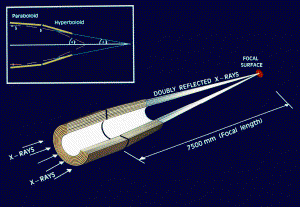Post
To Your Scattered
Photons Go
12 September 2013
Yesterday I wrote about the cosmic x-ray background, and I noted that x-ray astronomy, particularly with high-energy x-rays is difficult. But what is it about x-rays that makes x-ray astronomy so challenging?
X-rays are electromagnetic waves (light) with very short wavelengths. Visible light has wavelengths between about 400 to 700 nanometers, while x-rays have wavelengths of 0.01 to 10 nanometers. Their wavelengths are roughly the size of an atom. Because of their very short wavelength and high energy, x-ray photons act almost like hard particles. At longer wavelengths they are known as soft x-rays, while at shorter wavelengths they are known as hard x-rays. Hard x-rays in particular are very good at penetrating material. This is what makes them useful used as medical x-rays or CT scans.
 XMM-Newton
XMM-NewtonThis ability to penetrate is problematic for astronomy. A telescope works by focusing light from a larger area to a smaller one. An optical telescope uses lenses to refract light or curved mirrors to reflect it. Radio waves bounce easily off conductive materials such metal, so large metal dishes can be used as radio mirrors to focus radio waves to the detectors. But because x-rays tend to penetrate material rather than reflect off them, you can’t focus them as you would visible light or radio waves.
But x-rays can scatter off certain materials if they strike the surface at a very low angle. Basically an x-ray photon can make a glancing blow off the surface of the material, which changes the direction of the photon slightly. So to make an x-ray telescope, you need to make a column of reflective surfaces nested within each other, as seen in the image above. Each layer scatters x-ray photons slightly, but the amount of deflection by each layer is different so that all x-rays entering the telescope are focused toward the detector.
If there x-ray photons were only scattered once, then they would only focus after a very far distance. So you add another column of reflective surfaces to scatter the x-ray photons again. With two scattering the length of your telescope can be reduced to a more manageable length of about 10 meters.
Of course there are other challenges. Because the x-rays come in at such a shallow angle, any defect in your reflecting surface can scatter them in the wrong direction, which reduces the sensitivity of your telescope. So the reflectors need to be extremely precise. Metals such as platinum can be used for lower energy x-ray reflectors, but high-energy x-ray reflectors require multiple layers of different materials as a scattering surface. This means that after you make the reflecting surfaces, you then have to vacuum deposit a few-atoms thick layer of a low density material such as silicon or carbon, then a layer of a high density material such as platinum, and keep doing that about a hundred times. You have to do this for each mirror. In the case of the NuStar x-ray telescope, for example, there are 130 concentric focusing mirrors.
One last thing. X-rays don’t penetrate through the Earth’s atmosphere much, so this x-ray telescope, which is about the length of a bus, has to be launched into space.
This is why x-ray astronomy is such a challenge.